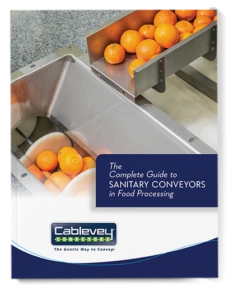Complete Guide to Sanitary Conveyors in Food Processing

The food industry is one of the most important and highly regulated industries in the world. The safety and quality of food products hinges significantly on the sanitary practices employed during processing. Having a complete guide to sanitary conveyors in food processing significantly eases the utilization and maintenance of conveying systems. Our guide delves into their pivotal role in upholding hygiene standards and offers insights into effective methods for sanitizing and cleaning conveyor belts
Fill out this simple form to download the PDF file.
The Importance of Sanitation in Conveyor Systems
Conveyor systems are integral to the production process, directly handling or coming into close contact with food products. As such, their cleanliness and sanitary condition have a direct impact on the safety and quality of the food being processed, affecting consumer health and trust. Let’s go over all the important benefits of conveyor sanitation:
- Food safety – sanitary conveyor systems help prevent the contamination of food products with pathogens, allergens, and other contaminants. This is essential for avoiding foodborne illnesses and ensuring products are safe for consumption.
- Regulatory compliance – the food industry is subject to stringent regulations and standards that mandate certain levels of hygiene and sanitation. Understanding and implementing proper sanitation practices for conveyor systems is necessary to meet these regulatory requirements and avoid potential fines or shutdowns.
- Product quality and shelf life – clean and well-maintained conveyor systems contribute to higher product quality by minimizing the risk of spoilage and extending the shelf life of food products. This is vital for maintaining brand reputation and customer satisfaction.
- Operational efficiency – regular sanitation and maintenance of conveyor systems can also lead to improved operational efficiency. Clean equipment is less likely to suffer from downtime due to malfunctions or breakdowns, ensuring a smoother and more consistent production process.
- Sustainability – effective sanitation practices can also contribute to sustainability efforts by reducing waste associated with spoiled products and ensuring efficient use of resources.
Cleaning vs. Sanitation - Why Both Are Crucial for Maintaining Food Safety
The specific requirements and practices needed to achieve optimal cleanliness and microbial safety differ among different automated conveyor systems. Cleaning refers to the removal of dirt, debris, and other physical contaminants from surfaces, whereas sanitation eliminates microbial threats that could compromise food safety. In the context of a conveyor belt system, including tubular and automated varieties, this differentiation is critical.
Effective cleaning processes remove particulates that can harbor bacteria, while subsequent sanitation procedures use chemical or thermal methods to kill any remaining microorganisms. This layered approach to hygiene ensures that conveyor systems are microbiologically safe, thereby preventing the spread of foodborne illnesses.
Adopting rigorous cleaning and sanitation protocols is essential for maintaining the integrity of food products, meeting industry standards, and protecting consumer health. They underscore the importance of both practices in the maintenance of hygienic and safe food processing environments.
We Set the Standard for Sanitary Conveying
Adhering to established sanitary standards helps conveyor manufacturers design and operate systems that effectively prevent the accumulation of bacteria and other contaminants. This commitment to sanitation is crucial for maintaining public health and complying with rigorous food safety regulations that govern the industry.
By establishing and following these strict guidelines, food processors can avoid costly recalls, protect their brand reputation, and ensure the longevity of their equipment. This way, they are contributing to a safer food supply chain.
It's Important to Adhere to 3A Sanitary Standards
A 3A Sanitary Standard is a cornerstone of maintaining the highest levels of hygiene and safety in food processing. These standards set rigorous criteria for the design, construction, and operation of conveyor systems to ensure they can be effectively cleaned and sanitized.
For a tubular conveying system, compliance with 3A Sanitary Standards is more than just following regulations. It’s about creating a surface that is easy to clean, using materials that don’t harbor bacteria, and designing equipment that prevents product buildup.
Optimize Cleanliness With Advanced Conveying Solutions
Optimizing cleanliness focuses on leveraging cutting-edge conveyor technologies to enhance food safety and hygiene in processing environments. As the food industry evolves, so do the demands for more efficient, cleaner, and safer production methods. Innovations in design and engineering have led to the development of clever conveyors that prioritize easy sanitation. This ensures that everything can be thoroughly cleaned and disinfected with minimal effort and downtime.
The role of conveyor engineering is crucial in this context. Cablevey Conveyors designs systems that meet the rigorous demands of food processing and incorporate features that facilitate hygiene maintenance. This includes:
- Smooth surfaces that prevent food particles from adhering,
- Materials resistant to corrosion and microbial growth,
- Configurations that allow for complete access to all parts of the conveyor.
Furthermore, the installation of these systems is just as important as their design. Conveyor installation supervision ensures that these sophisticated machines are set up correctly, adhering to all sanitary design principles. Proper installation ensures that the advanced features engineered for cleanliness are fully functional, making the system reliable for food processing needs.
Enhance Your Food Safety Practices With Cablevey Conveyors
Secure the future of your food processing operations by adopting the most advanced and sanitary conveyor solutions available. Download our comprehensive guide and contact us today to gain insights into selecting, operating, and maintaining a tubular conveyor that meets the highest standards of hygiene and safety. With expert advice on conveyor manufacturing, installation, and cleaning protocols, you’re empowered to make informed decisions that enhance product quality and consumer trust.

